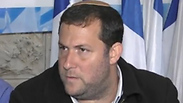

Land of dispute: tour of the West Bank, 50 years after Six-Day War
From Israel’s largest organic farm, run by the ‘inventor of outposts,’ to Jericho, where residents are letting go of the dream to become the next Dubai; from the pre-army academy in Eli, to the crowded crossings, where thousands of Palestinian laborers shove their way into Israel; and between Palestinian stone throwers and soldiers who just want to get back to their base.
We arrived on a Monday afternoon, after traveling across the West Bank for four intensive days, which were packed with meetings, protests and roadblocks. Jericho was supposed to be our last stop. Only after sitting down with Hitham Daraghmeh, whose face was weary from working in the field in the heavy heat, we asked ourselves if we shouldn’t have actually started our journey here, in Jericho—perhaps the city that symbolizes more than any other place in the territories the ups and downs that we and the Palestinians have gone through in the 50 years since the Six-Day War and the occupation of the area west of the Jordan River.
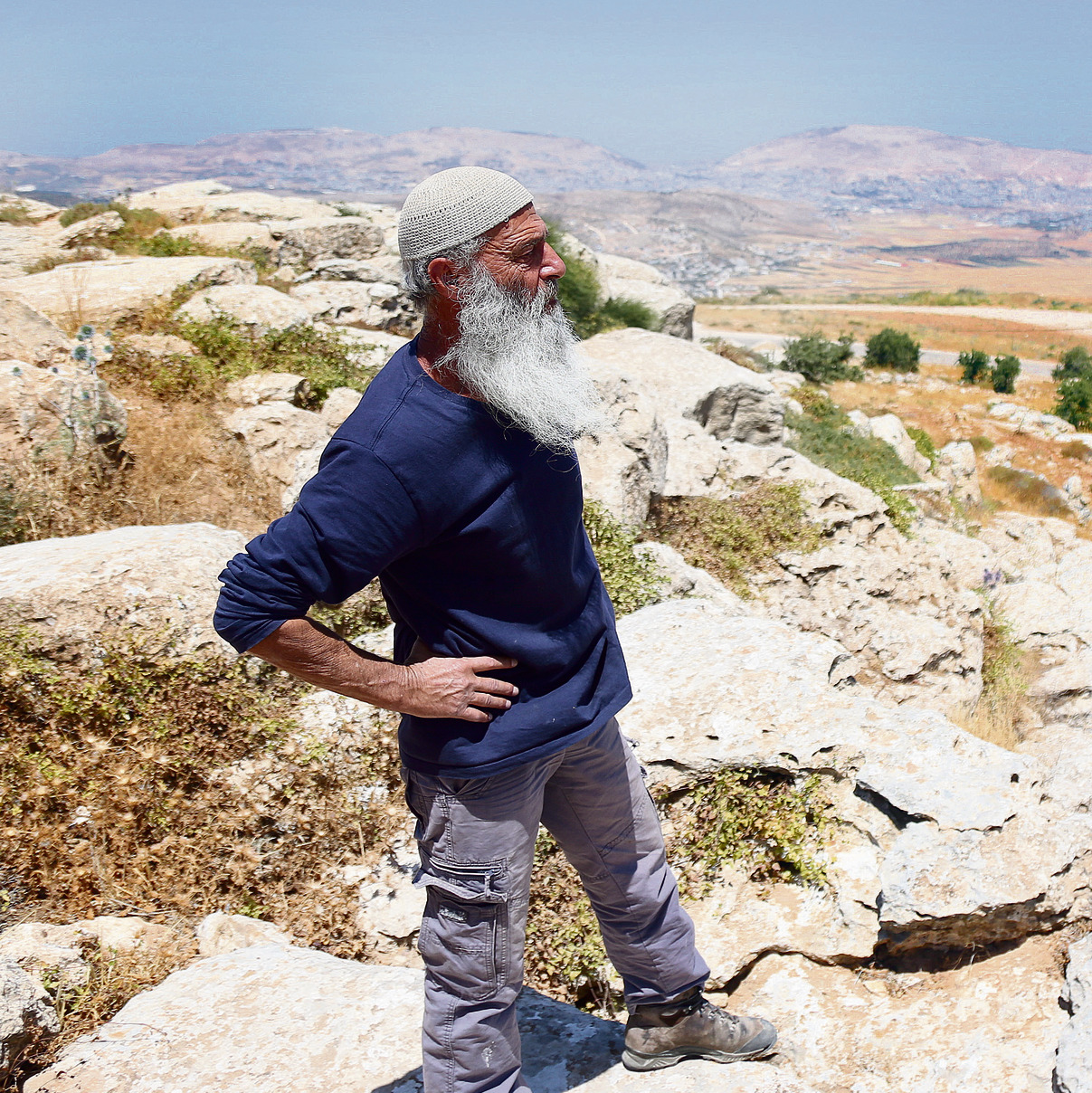
Hitham, 47, was born in the town of Tubas, east of Nablus, west of the Jordan Valley. He is a peasant and the son of a peasant. He remembers how, 23 years ago, on May 25, 1994, the IDF withdrew from Jericho as part of the Cairo Agreement, in which Israel pledged to transfer Gaza and Jericho first to Palestinian control. He remembers how he sat in front of the television in his house in Tubas, watching the convoy of Palestinian police vans entering Jericho and being greeted with candy and rice and tears of joy.
“I was married, with two small children, barely making a living from agriculture. They said that Jericho would be like the region’s Dubai, that all of the Gulf states and the world would invest in it. People turned up here in droves, just like people had rushed to America to search for gold 150 years ago. Most of them were young people dreaming of a new future, of freedom without an occupation, without seeing an Israeli army in front of their eyes anymore. That’s how I moved here too with my wife and two children, and I had four more children here.
“Wallah, there was hope that Jericho would thrive, that it would become the Palestinian America. And there was prosperity, definitely compared to other places in the West Bank, and Israelis came to the casino and there was commerce and traffic. And suddenly it stopped, it ended in the Al-Aqsa Intifada. Now look at Dubai and look at us.”
Later, traveling through the streets of the world’s most ancient city, we understood what Hitham was talking about. Jericho did not get any glass buildings and intimidating shopping centers filled with luxury brand stores. It remained small with low-rise houses, and on almost every street there are many open areas which have not been used for construction. It has large bases that serve the Palestinian security forces, a police academy, a prison, two refugee camps, a cable car for tourists who seldom arrive and one casino at the entrance to the city, Oasis, which was barely open for three years before being shut down at the start of the second intifada. Since then, it has been abandoned, standing there with locks on its large doors. This is where the Palestinian dream began following Oslo and this is what it looks like today, stuck in time.
The lands occupied in Judea and Samaria in 1967 cover a total of 5,790 square kilometers (2,235 square miles). About 2.5 million Palestinians live in those lands According to different estimates, and about 420,000 Israelis according to Central Bureau of Statistics figures. There were no Jews living here at the end of the war, and a population census conducted by the army shortly afterwards counted some 700,000 Arab residents across the West Bank.
The deep intergroup cleavages in the two societies, the Israeli and the Palestinians, fed on each other and set in motion processes which changed the reality on the ground. They generated the settlement enterprise and the Palestinian uprising which blew up on the ground in two intifadas.
It isn’t easy to present an image of the day-to-day reality in the territories. Nevertheless, in Jericho we heard about the dream and how it was shattered, but also about the spirit of Palestinian business entrepreneurship which keeps hoping for better days. In Eli, we heard about the birth of the national-religious public’s pre-military academies, which today feed the army with officers in key positions all over the fighting units, most of whom settle later on across the West Bank and reinforce the Israeli foothold in the area. In Avri Ran’s farm in Givot Olam, above the settlement of Itamar, we heard about how the outposts were born and about the idea behind them.
We woke up at an early hour to stand in line with the construction workers who enter Israel every day to build our homes. Squeezed in crowded rows, hopeless and depressed, they are expected to arrive at the construction site at 7 am, and must therefore leave their homes three or four hours earlier. And at the entrance to the village of Beita, near Highway 60 in Samaria, not far from Hawara, we documented a Friday protest. We stood on the side, taking pictures and taking notes. We were cursed by soldiers who tried to stop us from watching reality as it is reflected to them every single day, all year long, perhaps in the course of the past 50 years.
The production line
Sitting on a mountain range above Highway 60, Eli looks like another typical settlement in the Binyamin region. Small streets and vegetation along the roads, private houses with tile roofs, five-story terraced buildings reflecting the community’s expansion, and satellite neighborhoods on almost every surrounding hill.
In 1988, four years after the community was founded, the Bnei David pre-army academy was established on the corner of HaErez and HaEgoz Streets. Its two founders, Rabbi Eli Sadan and Rabbi Yigal Levinstein, wanted to create an educational institution which would prepare young men from the national-religious public for meaningful IDF service, focusing on providing religious and halachic tools so that they would not drift away from religion during their service.
Shilo Adler, 38, a regiment commander on reserve duty, is a graduate of the pre-army academy and serves as the chairman of its executive committee and as the director of the Yesha Council. He lives in Eli near the homes of Major Roi Klein, who was killed in the Second Lebanon War, and Major Eliraz Peretz, who was killed on the Gaza border. Colonel Eyal Asraf, deputy commander of the Gaash Division, lives across the street. Other neighbors include two regiment commanders, one in the Armored Corps and one in the Paratroopers Brigade, and company commanders on reserve duty. They are all graduates of the pre-army academy. Their neighborhood, Hayovel, was at the center of a High Court petition and evacuation demands, until the state announced that the place would be regulated and that the homes of fallen soldiers Klein and Peretz would not be evacuated.
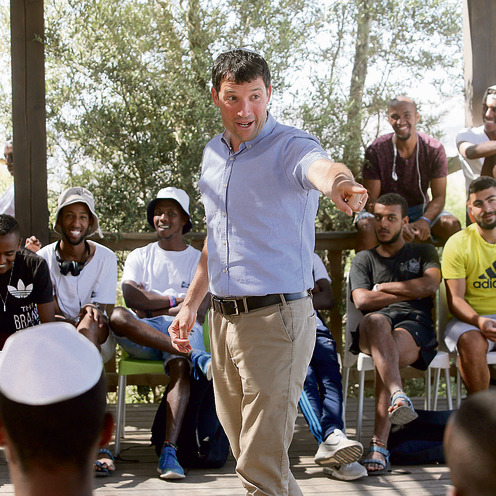
Adler was born in the Golan Heights and raised in Jerusalem. He arrived at the Bnei David pre-army academy after high school, before joining the Golani reconnaissance unit, where he served as the commander of a support company in the brigade.
“Before the pre-army academy was established, we only had hesder yeshivot,” he says, “and their graduates performed partial service in religious platoons. Whoever wanted a meaningful service in elite units couldn’t do so there. Some gave up their dream and others enlisted for regular service. Many had trouble coping with their encounter with the secular society and, unfortunately, left the religious world. And then came Rabbis Sadan and Levinstein.”
Rabbi Levinstein created a public row this year following comments against women’s service in combat units, and Defense Minister Avigdor Lieberman even threatened to stop recognizing the yeshiva as a pre-army academy.
The first class, in September 1988, had 70 students. The graduates of that class included Eli Gruner, who serves today as the director-general of the Prime Minister’s Office; Brigadier-General Ofer Winter, who served as commander of the Givati Brigade during Operation Protective Edge and is now chief of operations at the Central Command; and Lieutenant-Colonel Emmanuel Moreno, a Sayeret Matkal officer who was killed in 2006 in a unit operation in the Beqaa Valley in Lebanon.
Today, the academy has 700 high-school graduates as its students, and has become a production line of fighters and officers. Adler says the academy educates its students to see the state as a supreme goal and to influence the state and its character, “while the army is your first stop as a grownup person in the state.”
Eli developed thanks to the academy, and not just Eli. “I studied here for a year and a half, and the social connection—together with the ideological background—made me and dozens of other graduates settle down here,” says Adler. “This connection of Torah, settlement and a meaningful service as army commanders contributed to the development of the entire settlement. And we are talking about people of high caliber, good, ethical people, who searched for an added value in life and found it here, in the settlement.
“The generation of founders of Gush Emunim were people filled with ideology, a pioneering spirit and faith. They put down roots on the mountain, established communities in Judea and Samaria, but they didn’t have a significant connection to the Israeli society. The generation that was educated in the pre-army academies and joined the military integrated into society. That’s the real revolution. We have become a significant component of the Israeli society.”
Samaria blog
We arrived at the entrance to the village of Beita in Samaria on a Friday, shortly after 12 pm. Earlier, we had entered the village of Hawara, which is located on Highway 60 as well, on the section leading to the city of Nablus and the adjacent settlements.
A week earlier, an Itamar resident travelling on the highway was attacked with stones by a crowd of protestors demonstrating in support of the Palestinian prisoners’ hunger strike. Fearing a lynch, he got out of his car and fired his personal weapon. The gunshots killed 23-year-old Muataz Tayeh of Beita. We searched for a protest and were sent to killed Palestinian’s village.
Friday is a day of protests in the territories. There are the regular protests, which began about 10 years ago following the erection of the separation barrier—in Bil’in, in Nil’in and in Nabi Salih. In Kafr Qaddum, a weekly demonstration is held in protest of the blocked access from the village to the road leading to it. The protests always begin after the afternoon prayer at the mosques, and there are always IDF soldiers and Border Guard fighters present. It’s the Friday routine in the West Bank, and it’s our soldiers’ routine there, while Israelis in the big cities flock to the cafés, markers and beaches.
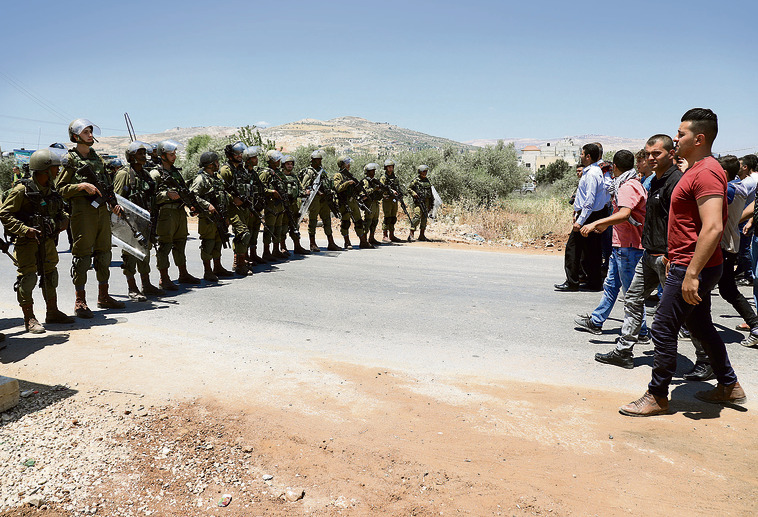
From here on, the chain of events will be presented as a blog, without any commentary: At 12:20 pm, at an observation point overlooking the entrance to Beita, there were two soldiers from the advance guard company of the Kfir Brigade’s Shimshon Battalion—the battalion of Sgt. Elor Azaria, who was convicted of manslaughter for shooting a wounded Palestinian terrorist in Hebron. They reported on the communication device that they had spotted young men heading down the access road to the village.
Less than 10 minutes later, a military jeep arrived with the company commander, an officer in the rank of lieutenant, and two soldiers. They watched the villagers approach the entrance with prayer rugs in their hands, place them on the road and prepare for the Friday prayer. At 12:45 pm, there were already some 200 people there, mostly young. The adults kneeled to pray, and the young ones dragged an iron construction which they used to block the road to the village. Two young men rolled tires and set up a barricade alongside the scrap iron. Two Palestinian photographers from Nablus arrived at the intersection, followed by others, including television crews. Within 10 minutes, we saw five photographers there, all equipped with gas masks and helmets.
An armored military vehicle loped over, unloading six soldiers. It was followed by another fortified vehicle carrying Border Guard fighters. Two additional jeeps arrived at the same time, as well as a white Civil Administration van with two officers. By 1 pm, there were more than 30 officers and soldiers from the Shimshon Battalion and the Border Guard at the junction. The soldiers wore helmets with a plastic shield on their faces and carried gas grenades and rubber bullet magazines.
Meanwhile, the growing crowd had already ended the prayer. The adults turned back to the village while the young ones remained, marching towards the watchful soldiers. They stopped in front of the troops, who pressed together to prevent them from going up to the main route and disrupting traffic. “We want an intifada that will release the prisoners,” they shouted and waved their hands. “Freedom to Palestine, freedom to Palestine.”
The deputy company commander stood behind the soldiers and shouted at them, “No one moves without an order from me. Is that clear?” For about 10 minutes, not a single soldier moved or reacted, although the protestors were virtually screaming in their ears.
I stood aside and took notes. I was spotted by an officer in the rank of lieutenant, wearing a tag of a Civil Administration unit, who approached me and asked who I was. I told him I was a journalist. He asked for a press card, read the details on it, gave it back to me and demanded to see what I had written in my notebook. I refused, and he threatened to call the police to detain me. I told him to go right ahead and call the police. At that stage, the crowd had pulled back and the tires were set on fire. The Civil Administration officer let go.
The protest moved to its next stage. Veiled men burst forth from among the young Palestinians and began throwing stones in elastic stockings at the soldiers, who started spraying them with tear gas. Two groups of soldiers at the side of the road began moving towards the stone throwers, as the main force fired gas at the middle of the road to scare the veiled men off. Under the smoke screen created by the gas and the burning tires, the soldiers started running towards the stone throwers, causing most of them to flee. Only one remained in place, raised his hand and give the V sign, as the thick black billowed behind him from the burning tires. It was the image the photographers had been waiting for. He didn’t try to escape, but let the soldiers push him down and handcuff him.
As the photographers ran towards him to take pictures, the soldiers tried to stop them by blocking the cameras lenses with their hands. Not a single officer scolded the soldiers or told them to focus on their mission. For years, soldiers have been guided not to try to prevent a media outlet from covering events in the territories, unless they take place in a closed military zone, which wasn’t the case that Friday.
A soldier who noticed me writing things down, approached me and muttered: “You traitor, you B’Teselem. They’ll come get you in Tel Aviv. Just you wait and see.” When I complained to one of the commanders, he brought the soldier over to apologize. “Today they’re still calm,” a Palestinian photographer said. Pointing at the soldiers, he added: “They usually treat us much worse. Today it’s okay, because you’re here.” An officer from the Civil Administration holding the rank of lieutenant-colonel, who saw me talking to the Palestinian journalists, said to me: “You can go work for them. You’re anyway talking to them.”
The soldiers kept firing tear gas and rubber bullets and the Palestinians kept throwing stones until around 4:30 pm, in growing intervals. From the side, the two sides seemed to have a regular protocol of conduct, with each side knowing the part it plays in the game. The overwhelming majority of the soldiers act professionally and stick to their mission. About an hour after the incident begins, all they are interested in is getting back to the base.
The IDF Spokesperson’s Unit offered the following response: “The IDF forces in the Judea and Samaria area operate under the political echelon’s decision to safeguard the area’s residents. The described incident is unusual, was carried out in violation of orders and does reflect the general conduct. We regret the soldier’s behavior and comment.”
Before preparing this story, we asked the IDF to let us join soldiers in riot-handling activities and in their daily activities in the territories, in a bid to experience them from their perspective, but were turned down.
‘Now starts the war’
Ahead of the protest, we ran into Imad Odeh, a 48-year-old construction worker from the village of Qusra, shopping in Hawara. He currently works at a building site on Tel Aviv’s Dizegoff Street. “Working in Israel is ‘ehsan,’ excellent,” he said. “I bring home 400 shekels a day, while here I would barely get 120 shekels. Without the work in Israel, we would have no money to live on.”
Today, the number of employment permits issued by the Civil Administration for Palestinian laborers in Israel totals 71,063. In addition, several thousand Palestinians who have no work permits—some for security reasons—enter Israel every day. They make their way to Israel through breaches in the security barrier or through places where there is no barrier. The Palestinians who do have a permit enter the country through 15 crossings, which are all highly congested, mostly on Sundays, when the laborers with week-long stay permits enter the country too.
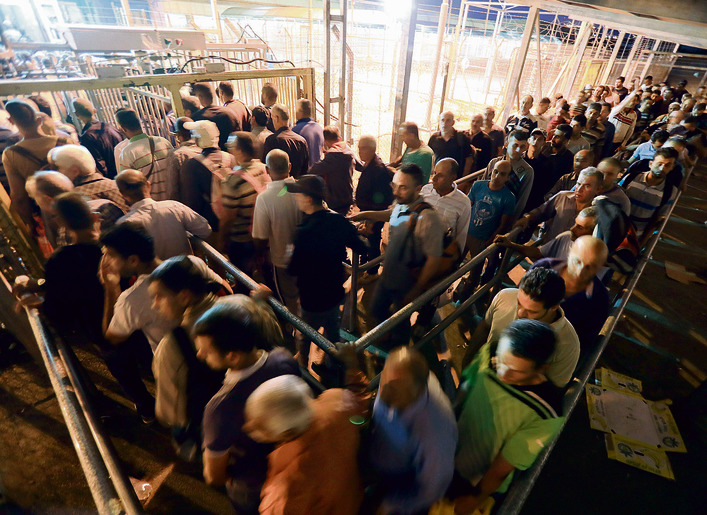
We arrived at the home of Naeem al-Beidah in the village of Jayyous in the Qalqilya area on a Sunday at 3:30 am. We were led to the house by Rachel Afek and Raya Yaron from the Machsom Watch women’s organization, which monitors the situation at West Bank checkpoints. Al-Beidah, a 52-year-old father of seven, works in Israel as a construction worker. These days, he is building a semi-detached house in Kfar Sirkin.
He gets up at 3 am, has his daily meal before the start of the Ramadan fast, gets ready and takes a shared taxi to the Eyal Crossing, which costs him NIS 8 each way. He works from 7 am to 3:30 pm and brings home NIS 500 per day. “But from that you must deduct the 2,300 shekels I pay on the ninth of each month for the permit,” he says, explaining that “the permits are received by a Jewish contractor who asks for a certain quota, although he doesn’t really have enough work for the number of permits he gets. So he makes a profit from the permits he has left. He sells them to laborers for 1,000 shekels more than they cost him. If you’re one day late in paying him, the contractor cancels your permit and you can’t get in to work.”
He enters the vehicle with us and directs us to the crossing, a 10-minute drive from his house. A moment before we arrive, al-Beidah takes a deep breath and says: “Now starts the war.” It’s 3:45 am, and the queue is already spilling into the street leading to the crossing. It’s 950 meters long before the Palestinian laborers come out on the Israeli side. On the way, there is shoving and shouting and downcast looks and slowly walking behind the laborer standing before you. And an older man standing in the crowded line shouts at us, “Take pictures and show the world what’s going on here. It’s hell.”
“Sometimes it takes 40 minutes and sometimes more than an hour,” al-Beidah says. “And it’s terribly crowded, depressing. Several weeks ago, a laborer suffered a heart attack while standing in line and died.”
He quit studying in the ninth grade and went out to work to help the family earn a living. “I worked in Ra’anana in a vegetable and fish store and at a shawarma stand. I know from stories that years after 1967, laborers used to enter Israel freely. There were checkpoints here and there, but they weren’t regular. Friendships were established between Palestinians and Jews. In the first intifada, they started giving us trouble. In the second intifada, they already made things very difficult for us. As a laborer, I come to the site and I don’t hang out outside, I don’t approach people. The fear is mutual. They are afraid of me, and I’m also afraid of the reaction towards me.
“The attitude towards us depends on the situation. When there are problems, the police come to find you, take you aside and check you slowly, shouting and humiliating you. It’s inhumane. And we are the ones building your state. All of Israel was built by the Palestinians. Even Israeli Arabs are no longer simple laborers. They’ve become managers and contractors. We do all the hard work and we have no complaints. But what about our dignity? Don’t we deserve to be treated like human beings?”
The last Mapainik
After catching a nap in the car, we went up to Avri Ran’s Givot Olam. Israel’s largest organic farm sits on am 850-meter tall mountain range, at the tip of Samaria, overlooking the Jordan Valley. There is no point in writing about the magnificent view. It’s breathtaking. Givot Olam Farm Ltd. is today a financial empire in the field of organic egg production and marketing in Israel.
Ran, 62, was born in the Negev and grew up in Kibbutz Nahsholim before becoming religious. He arrived in Samaria shortly after the Oslo Agreements were signed.
“I lived in Moshav Meir in the Jerusalem corridor and owned a farm,” he says, “and I got to know this area from my reserve service in the Armored Corps. I didn’t understand why people were living here in prefabricated cubic buildings and caravans, surrounded by barbed wire. I wanted to come here and settle the way I understood. To break through the fences, to go up and settle like a Mapainik, without asking too many questions. The Mapainiks turned everything they saw into their own. They didn’t care about anyone. They saw a swamp and said, we’ll turn it into a banana plantation. They went there, dried it up and created a banana plantation. That’s how I was raised in the kibbutz.”
His settlement on the hills received wide media coverage. Arrests, trials, violent brawls with Palestinians. This isn’t the case this time. He climbed here step by step. He began in a place called “The Spot,” moved on to Hill 851 and then came up here. “And this is where I stopped, because I ran out of fuel,” he says with a smile.
He was surrounded by young men like Dov Driben of Kiryat Arba, who went on to establish the Havat Maon outpost, where he was murdered, and Yitzak Skali, who built his own farm opposite Givot Olam. “Special teens arrived, outstanding guys who would go from one funeral to another at the time, who were hit with one disaster after another, and no one knew how to ease their frustration. And here they learned how to work the land, to remove stones, to build wooden houses, to take a tractor and plow.”
Givot Olam was the harbinger of the following outposts, 110 of them. “If I hadn’t come here, we would still be living in communities surrounded by barbed wire fences,” Ran says. “People from the settlement establishment fought with me. They hated me, and I wouldn’t stop. I didn’t ask permission from anyone. I got up in the morning to dry swamps like a Mapainik.”
Yossi Dagan, head of the Samaria Regional Council, calls Ran “the inventor of outposts.”
“He led a strategic move, the effect of which we are feeling today and will keep feeling for many decades to come. He educated an entire generation, idealist people who were burning with love for the land, and turned them into skilled farmers and building contractors who took the settlement one step forward. He should receive the Israel Prize for the move he led.”
“There were years in which I had a bed in the detention center and a bed in the hospital,” Ran recalls. “I was on the verge of bankruptcy, but I didn’t stop. Nothing stopped me from continuing to create a reality on the ground here, and my approach was that I don’t care about the Arabs. We came here to settle our land. Dozens of young couples who worked and met here moved on to settle outposts in the hills—Havat Gilad, Givot Itamar, Givot Yitzhar, Givot Bracha, Emek Shilo. We weren’t alone. We got help from the Amana movement (the Yesha Council’s settlement movement), and we deployed in different areas on the ground with a clear goal to block future agreements.”
Dagan nods in agreement. “The settlement has expanded across the land and created a new reality,” he concludes. “The possibility of uprooting the settlement from here no longer exists. It’s passé.”
Adding insult to injury
Shortly after the entrance to Jericho, after the turn to the closed casino and before the left turn to the Aqabat Jaber refugee camp, we stopped to take a picture of a large key with the caption, “We Will return.” Together with B’Tselem field coordinators Karim and Jubran, and ‘Aref Daraghmeh, the organization’s investigator, who is in charge of the Jordan Valley and Jericho area, we went to the agricultural farm that employs Hitham, who came to Jericho with the hopes of starting a new life.
“Today it’s easier for me to cross over to Jordan through the crossing located 3 kilometers from here than to go visit my family in Tubas. By the time I get to them, I’m out of breath. There are checkpoints everywhere and the certificates are checked in every checkpoint. They check the trunk and sometimes you even have to take your pants off.”
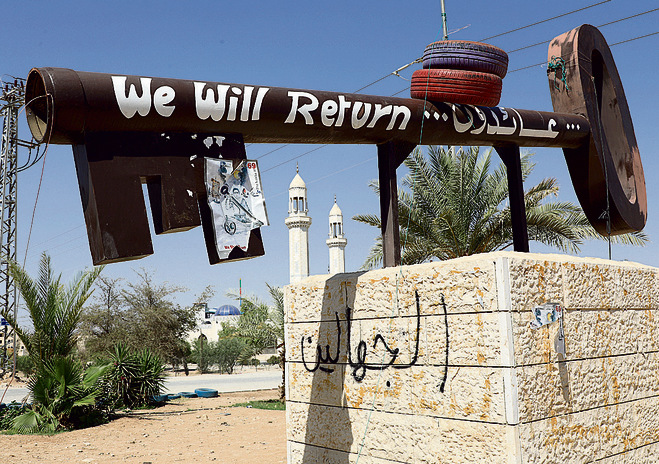
From there, we moved on to Omran Muhammad Amer, a 53-year-old restaurant owner who was born in Jericho. “We had some tough years, but now there’s a recovery. They built a concrete factory here and an iron factory and a plastic factory, and workplaces have been added. The proximity to the crossing makes the existence of businesses and large factories possible. Life and initiative are stronger than anything.”
We asked him if he believe there would ever be peace. “I don’t know. You’re the ones who are afraid of peace,” he replied.
We bid farewell to the city and to the people who accompanied us. A moment before leaving, we pay a visit to Mustafa Awidat in the Aqabat Jaber refugee camp, whose crowded houses create a depressing feeling of suffocation.
He is 45 years old and works in the Palestinian laborers’ organization. His family comes from the former village of Dayr Aban in the Beit Govrin area. He was born in the camp, and clarifies that the refugee camps are the result of 1948—the War of Independence for us, the Nakba for the Palestinians. The occupation of the West Bank in 1967, he says, was “a blow of humiliation, of adding insult to injury.
“But we don’t care about 1967,” he adds. “We are against any agreement based on the ’67 borders. My grandfather’s dream was to return to our village one day, and my father had the same dream until he died seven years ago. I am keeping the dream and the hope going, and if it doesn’t happen in my lifetime—my children will keep hoping and dreaming. We have the key to the house, and the key is passed on from one generation to the next. You dreamed about coming back here for 2,000 years, and we have been dreaming for only 70 years now. Do you expect us to forget in 70 years what you haven’t forgotten for 2,000 years?”















